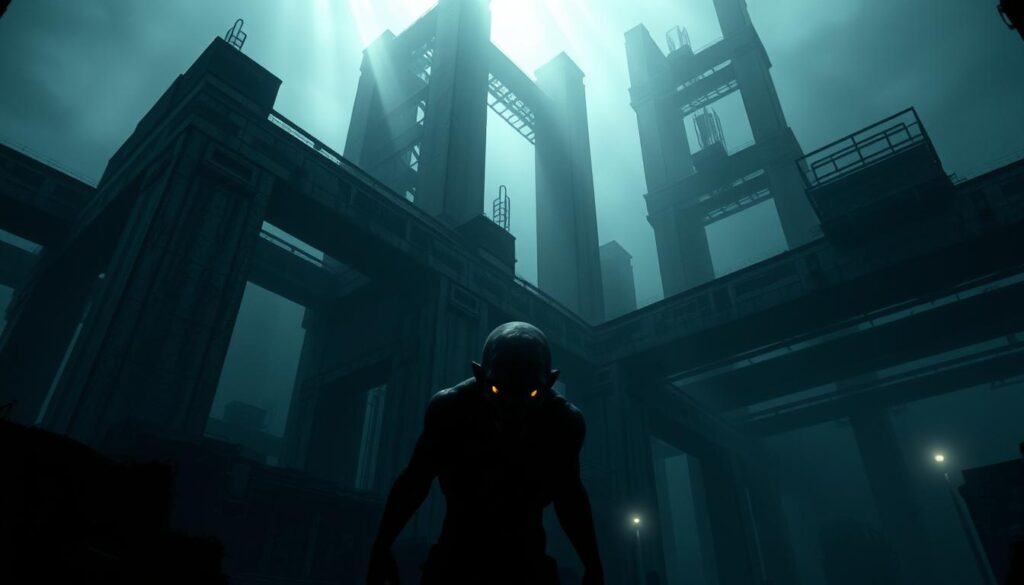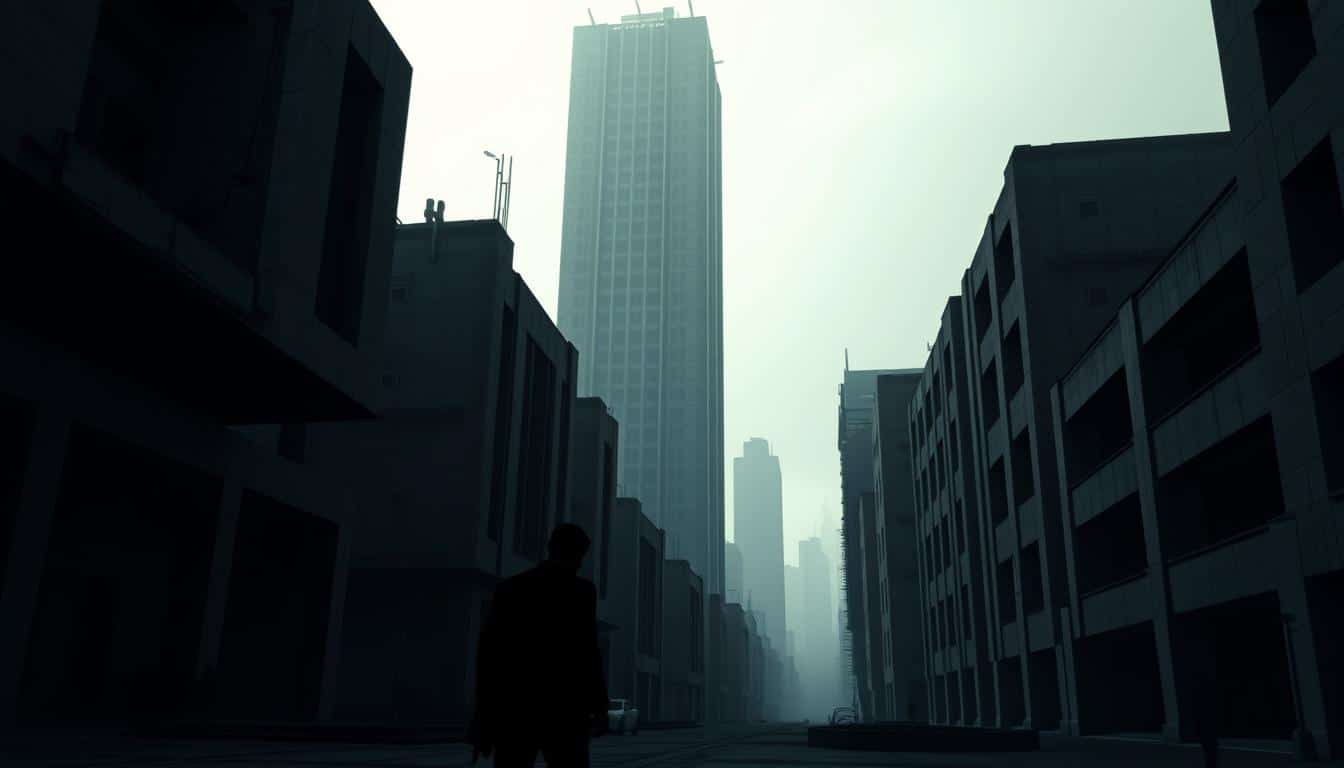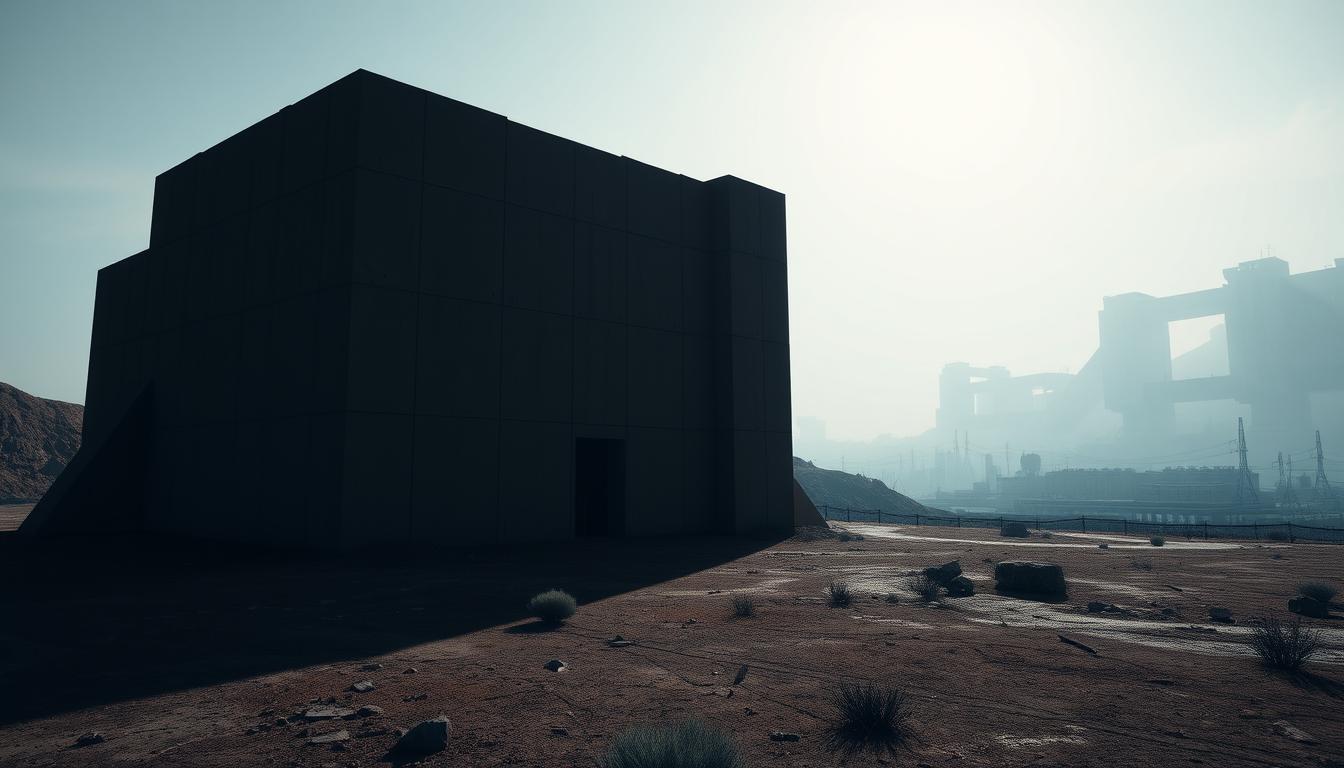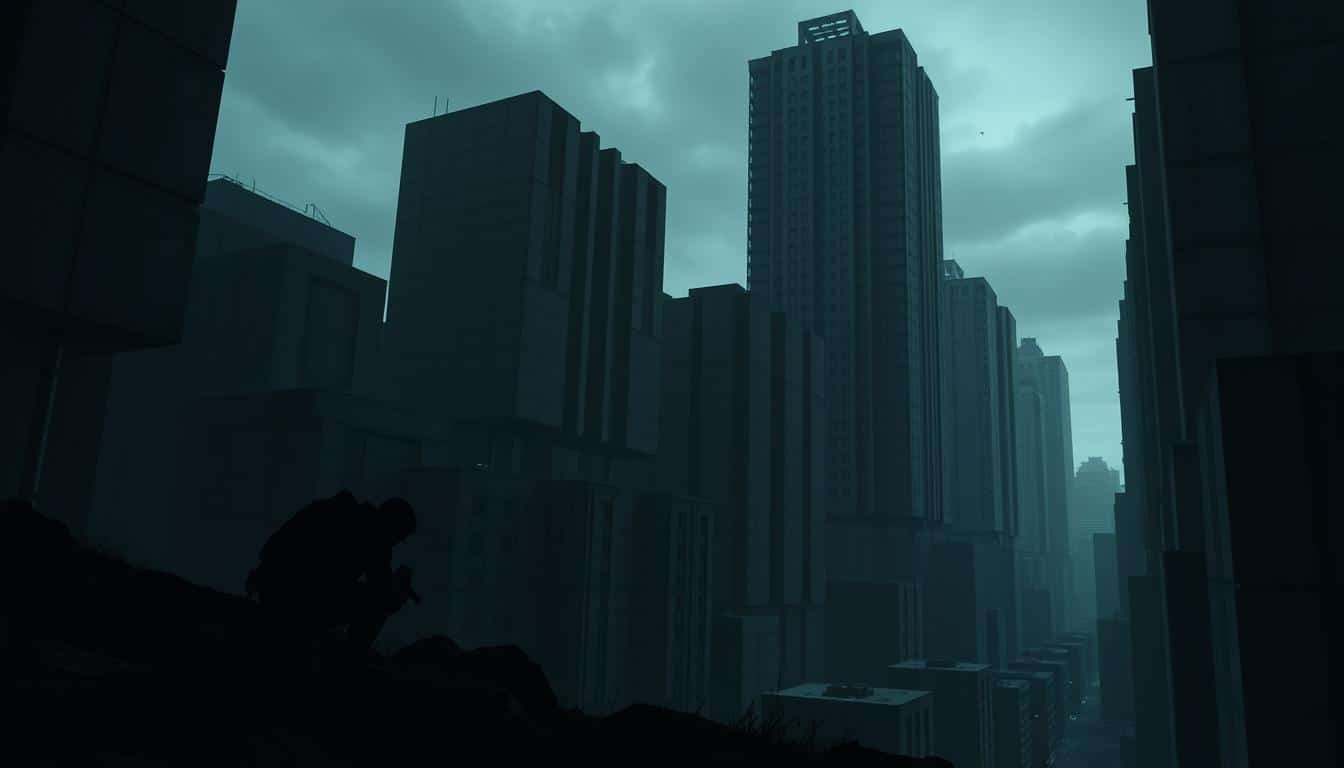Brutalist design is now a key element in horror game creation. It shapes how players see stories and feel atmospheres. This style is known for its simple, raw concrete looks.
It makes environments that match with fear and feeling alone. As players move through video game worlds, brutalism’s rules help tell the story. They make the gameplay’s emotional impact stronger.
Looking at brutalist design’s special qualities shows us how it boosts horror games. It deeply engages players in unique ways.
The Rise of Brutalism in Horror Gaming
Horror gaming’s design has evolved interestingly with brutalism’s comeback. This style, known for its stark, unfinished looks, has become a key way for game creators to bring out feelings of unease and fear. They use harsh concrete buildings and big, bold shapes to make worlds that are unsettling.
There’s a growing love for brutalism in games, part of a trend that digs into nostalgia and old-school graphics. Players get pulled into these tough, metallic scenes that remind them of cities falling apart. This feeling builds a deep sense of alarm. As games keep evolving, using brutalism helps developers shake up usual story methods. It encourages players to dive in and face their fears in big, dream-like places.

Understanding Brutalist Architecture
Brutalist architecture started in the mid-20th century. It features large, block-like shapes made mostly from raw concrete. This style was born during a time when countries were rebuilding after war. The big concrete buildings of brutalism showed strength. Yet, they also seemed very strict and all the same.
These buildings often look cold and not welcoming. They reflect the big worries and political issues of their era. Many see these buildings as overpowering, making people feel left out. This feeling is why they’re used in horror games. In such games, the setting can make the fear and tension stronger.
Brutalist Design Principles in Horror Video Game Development
Brutalist design is key in horror video games. It uses raw elements to draw out deep feelings from players. The mix of physical space with our emotions builds emotional architecture. This makes the game’s world feel more real, tying into themes of being alone and in control.
This approach uses architecture to increase the story’s suspense. The designs are chosen with care to help tell the story.
Creating Emotion Through Architecture
Designing spaces in horror games affects how players feel. Huge, bare brutalist buildings make players feel small and scared. Features like:
- Large concrete walls
- Long, empty spaces
- Odd shapes that mess with your head
These design choices stir up feelings. They help players feel more connected to the game’s story and scare them more.
Conveying Themes of Control and Isolation
Control and being alone are big themes in horror games. Brutalist designs show these ideas with big buildings that trap and confuse players. Features like:
- Tight spaces in huge areas
- Complex designs that confuse
- Big buildings that feel like a trap
These tricks with space make players feel stuck. They match the game’s themes, making the horror experience feel more real.
Iconic Examples of Brutalism in Video Games
Brutalist design creates unforgettable experiences in video games. Its bold look strengthens the story and feel. Games like NaissanceE and Control show this well. They use buildings and structures to spark feelings from being alone to curious.
NaissanceE: A Cult Classic
NaissanceE offers a unique look at a giant changing structure. Its strange scenery makes players feel uneasy and lost. This takes them deep into a brutalist world.
The game’s impact comes from how it makes players react emotionally. The way it’s designed makes people really think, earning its place as a cult favorite among unique video games.
Control: The Ominous Oldest House
In Control, players enter a world centered around The Oldest House. This brutalist building is all about power and mysteries. It draws from real buildings like the Long Lines Building.
Its design brings in a feeling of control and unknowns. This shows how brutalism can influence how players see and feel in the game’s story.
The Aesthetic Appeal of Brutalism
Brutalist structures capture the attention of both creators and players. This style highlights raw beauty and starkness, which some find deeply moving. The simple concrete, sharp edges, and strong shapes make up a unique visual language loved in gaming.
In horror games, combining brutalism with minimalist design makes a gripping setting. This mix brings a special atmosphere to stories.
These buildings give off a feeling of power and control. They make horror games more immersive, pushing players to face their fears in these simple yet daunting spaces. The minimal design helps players connect more with the game’s story.
Developers see the hidden beauty in brutalism, using it to stir deep feelings. By adding these elements to games, designers create unforgettable experiences. This blend of looks and feelings shapes the future of horror gaming.
Brutalist Structures and Player Experience
Brutalist architecture impacts how players feel in games, especially with its big size and look. These huge, concrete buildings give off a massive vibe that can leave players feeling lost. Game makers use this style to bring out feelings of fear and smallness, making games that really pull you in.
Exploring Scale and Perspective
Horror games use big, imposing settings to change how players feel. These large areas can make players anxious because of their overwhelming size. This big scale not only offers a stunning view but also makes players feel alone in a huge, uncaring world.
Key aspects of exploring scale and perspective include:
- Overwhelming environments that evoke a sense of fear.
- Strategic use of perspective to enhance immersion in the game world.
- Architectural design that emphasizes player vulnerability.
As players move through these daunting places, the sense of size becomes a way for game developers to stir up feelings. Mixing brutalist designs with smart game play leads to a strong story that sticks with you.
Utilizing Brutalist Design for Horror Atmosphere
Brutalist design is key in making horror feel real to players. Its stark, simple forms stir deep feelings. They make us feel alone and lost. This style uses raw materials to build spaces that scare us and play with our emotions.
Creating a Sense of Alienation
Big, blocky structures make players feel small and helpless. They enter a world where they don’t fit in. The cold concrete and sharp angles make everything feel tense. Players face their fears alone in these spooky places.
Manipulating Player Emotions with Space
Space and light mess with how players feel. Obstacles and mazes make them feel trapped and scared. Shadows and bright lights keep them tense. These tricks make the horror even more real and scary.
The Human Element in Brutalist Video Games
Brutalist video games offer a special mix of stories and architecture. Developers use brutalism’s stark nature to create relatable stories. These games connect deeply with social topics, making players think.
Personal Stories Reflected in Game Design
Many brutalist games show personal stories linked to society’s bigger issues. They delve into identity, mental health, and existential questions. This leads to players feeling closer to the characters and their journeys. Developers make these bleak settings a backdrop for rich storytelling.
The Social Commentary of Brutalism
Brutalism’s tough history and look help discuss social themes in games. It makes players face tough realities and question modern society. This deep look into human experiences challenges and enriches the player’s understanding of their own life and the world around them.
Challenges of Implementing Brutalist Design
Bringing brutalist design into video games is tough. Developers work hard to keep games looking good and playing well. They must balance the bold look of brutalism with the game’s fun factor. This task is tricky. They aim to mix these parts well, without losing player interest.
Balancing Aesthetics with Gameplay Functionality
Sometimes, the look of brutalism can take over the game’s needs. The game’s functions have to fit with this unique style. If not, players might not enjoy the game. Designers try to make game areas that fit with brutalism. Also, they make sure players find these areas fun to explore. They have to line up the game’s look with how it plays, which is not easy.
Preserving the Philosophical Roots of Brutalism
When using brutalist style, the game makers also think about its deep meanings. Finding the balance between style and fun play is key. They don’t want to water down brutalism’s big messages. Keeping its spirit can make the game more interesting. This approach helps players feel a stronger bond with the game world, beyond usual game cliches.
Future Directions for Brutalist Design in Gaming
The future of brutalism in games looks big as tech grows. Developers will likely try new ways to make games more interactive and real within the brutalist style. As game engines improve, capturing brutalism’s true spirit should get easier, allowing designs to grow deeper.
Indie game makers play a big role in shaping game trends. Their willingness to test new ideas and take risks helps bring fresh brutalist looks to games. This could make brutalism popular again in surprising game types, keeping it important in today’s gaming world.
Also, more immersive experiences might get players to dive deeper into brutalist elements. This shift could make it easier to tell complex stories through simple architecture, linking design and narrative closer together. With developers trying out these new methods, brutalism’s impact on games will likely keep growing.
Conclusion
Looking into how brutalist design affects horror games shows its big impact on how we feel when we play. This style does more than make the game look a certain way. It also makes the story pull us in deeper. It creates a world of emotion that sticks with us after we’re done playing. Brutalist design’s use of stark and raw elements amps up the feeling of control and being alone in horror games.
In games like Control and NaissanceE, brutalism’s role is clear. It shapes how we move through the game, filled with tension and fear. The spaces are more than just backgrounds. They’re part of the story, making the scare factor even bigger.
As games keep getting better, the mix of brutalist architecture and deep feelings will keep inspiring new ideas. Designers have a great chance to keep using brutalist ideas. This guarantees it will stay important in horror games, making our connections to these digital worlds stronger.



